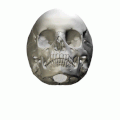| Temporal styloid process | |
|---|---|
 Right side of the skull. Styloid process shown in red | |
 Right temporal bone and mandible (styloid process labeled at bottom) | |
| Details | |
| Identifiers | |
| Latin | processus styloideus ossis temporalis |
| TA98 | A02.1.06.047 |
| TA2 | 683 |
| FMA | 52877 |
| Anatomical terms of bone | |
The temporal styloid process is a slender bony process of the temporal bone extending downward and forward from the undersurface of the temporal bone [1] just below the ear.[ citation needed ] The styloid process gives attachments to several muscles, and ligaments.








